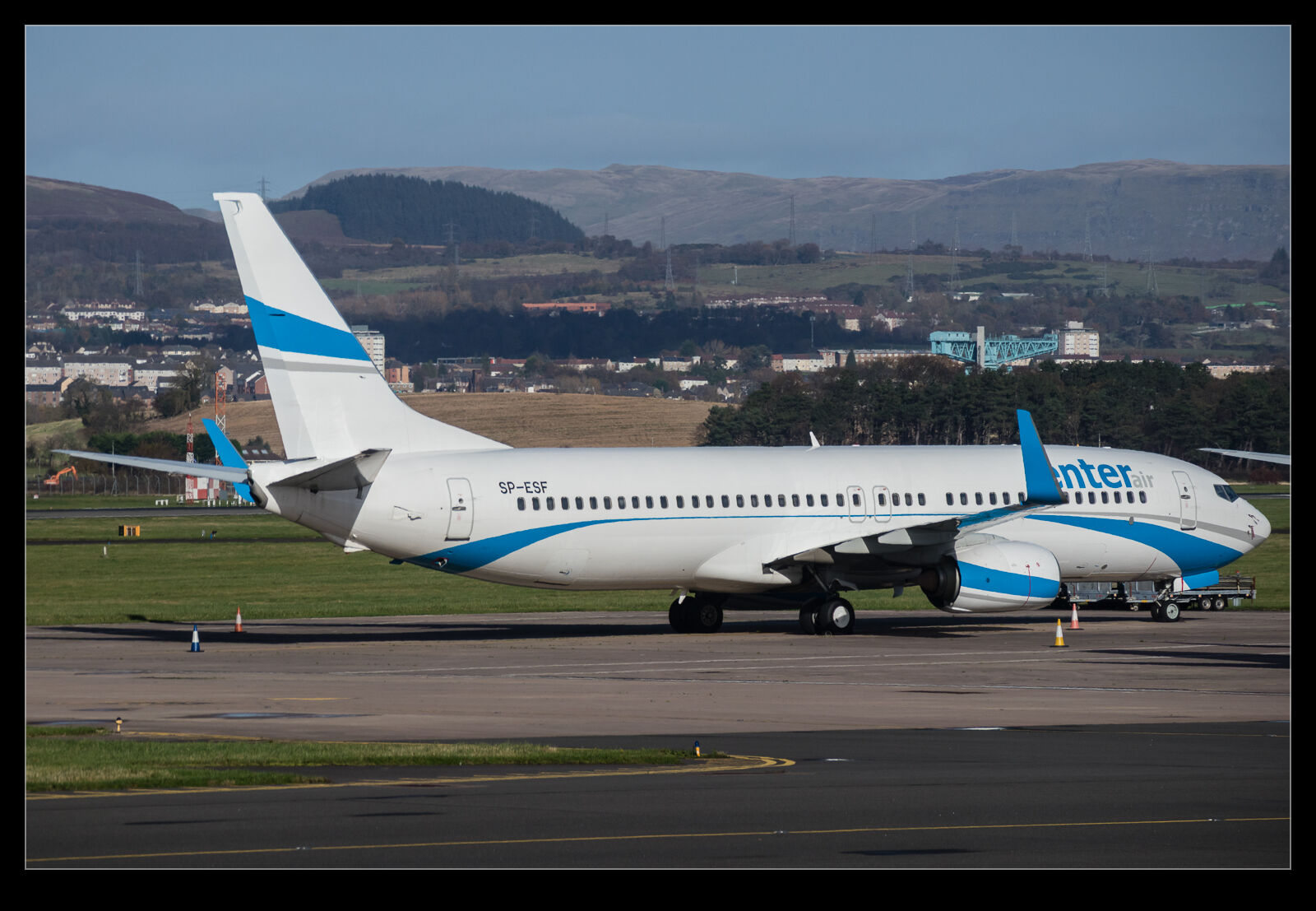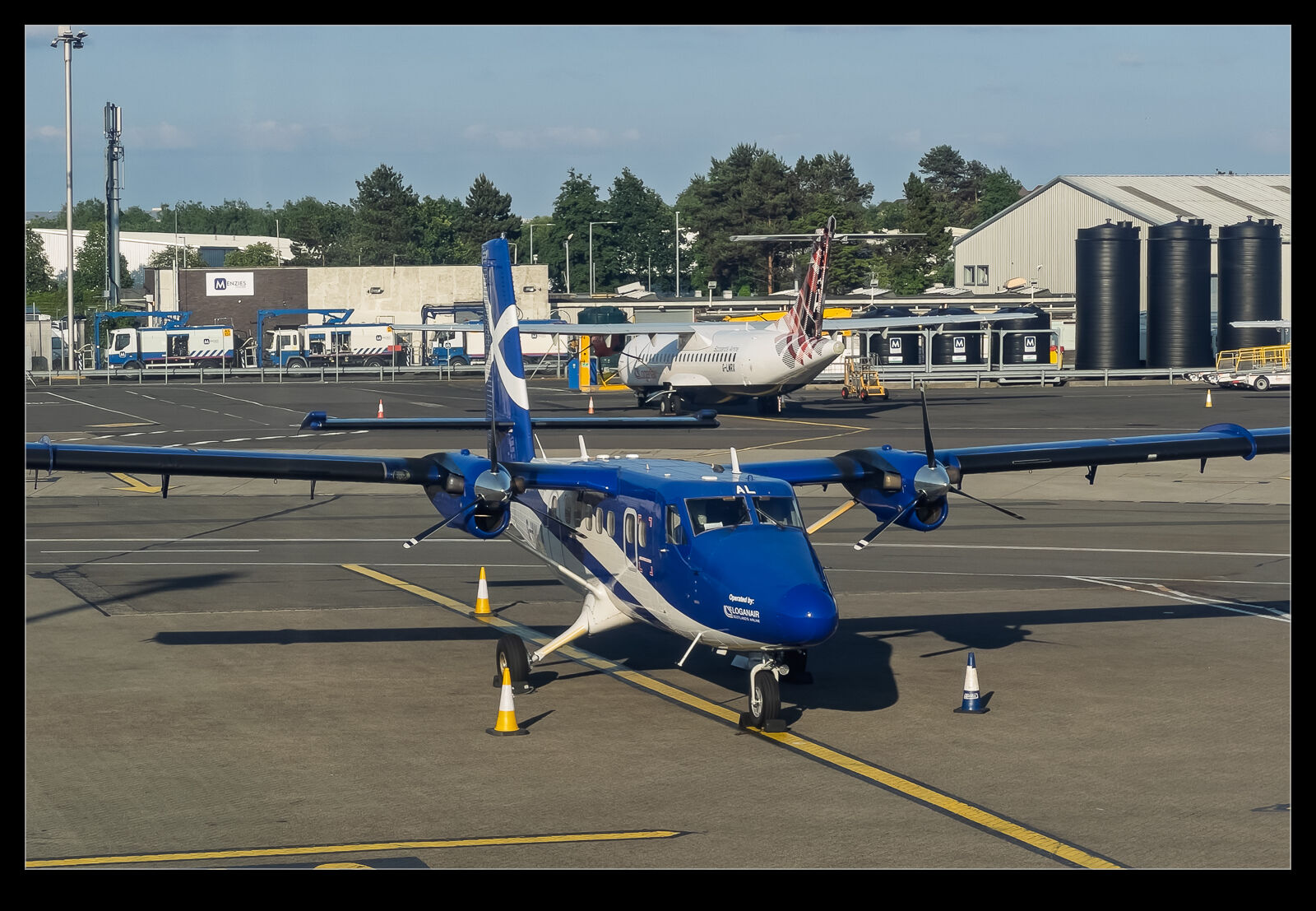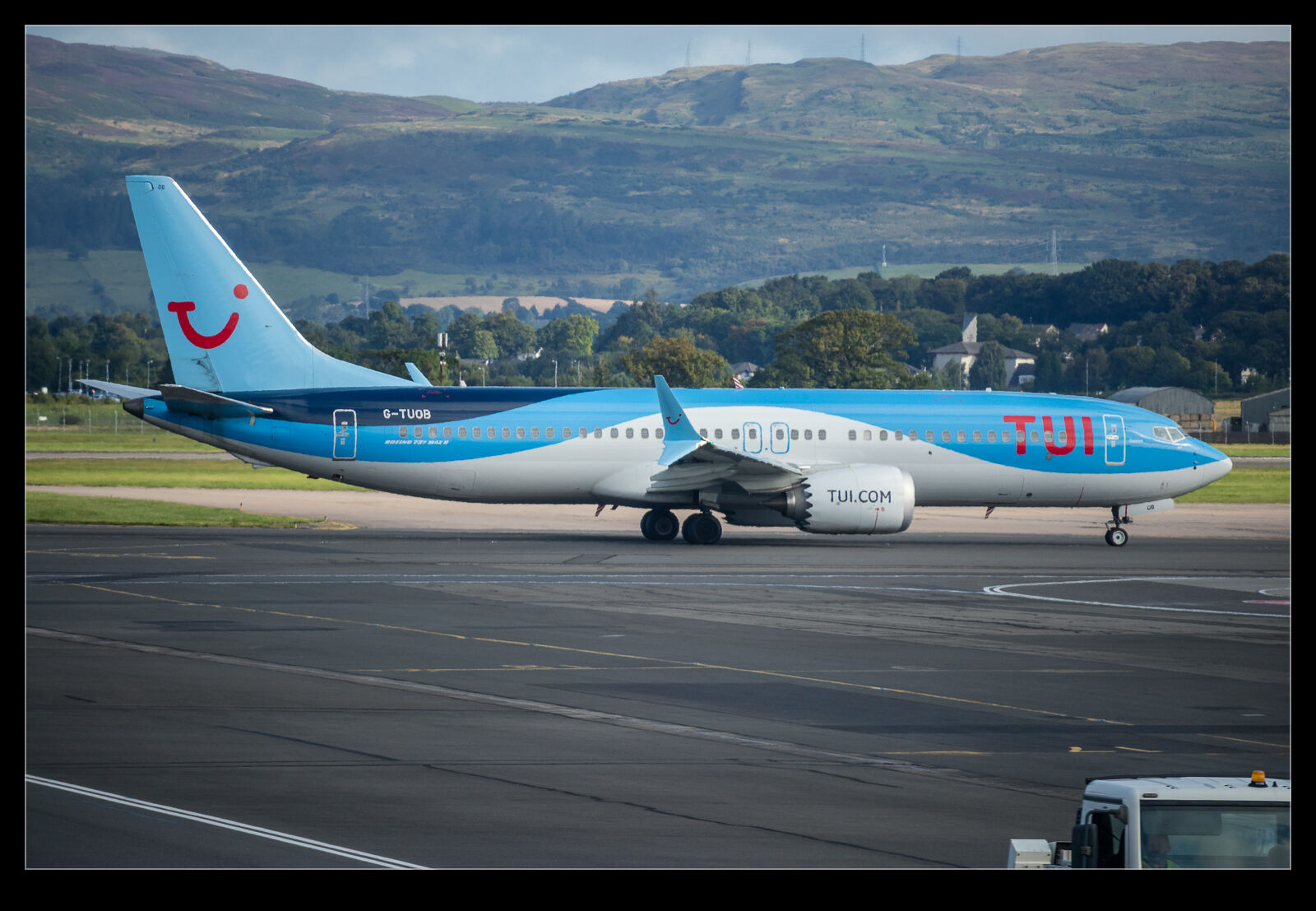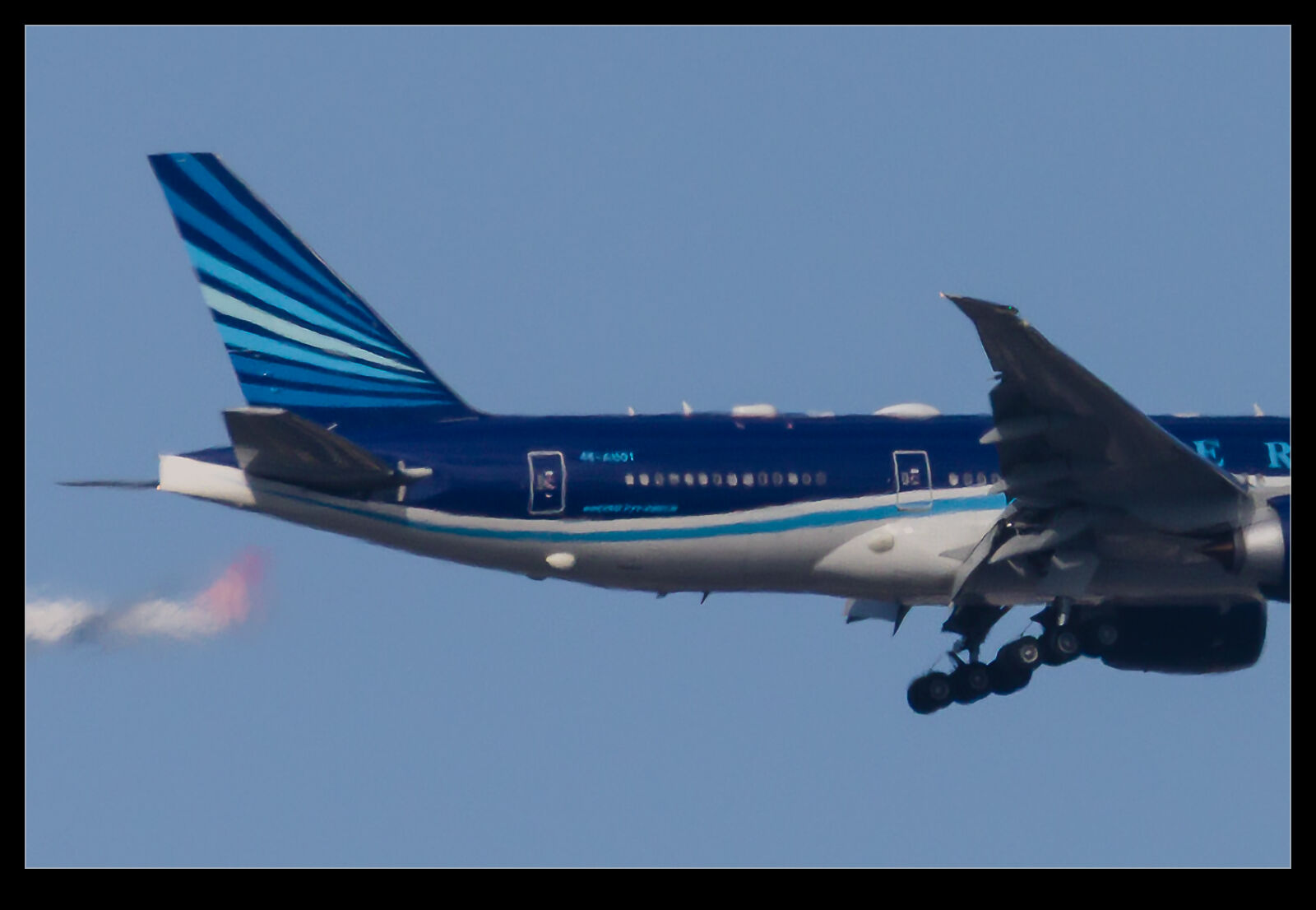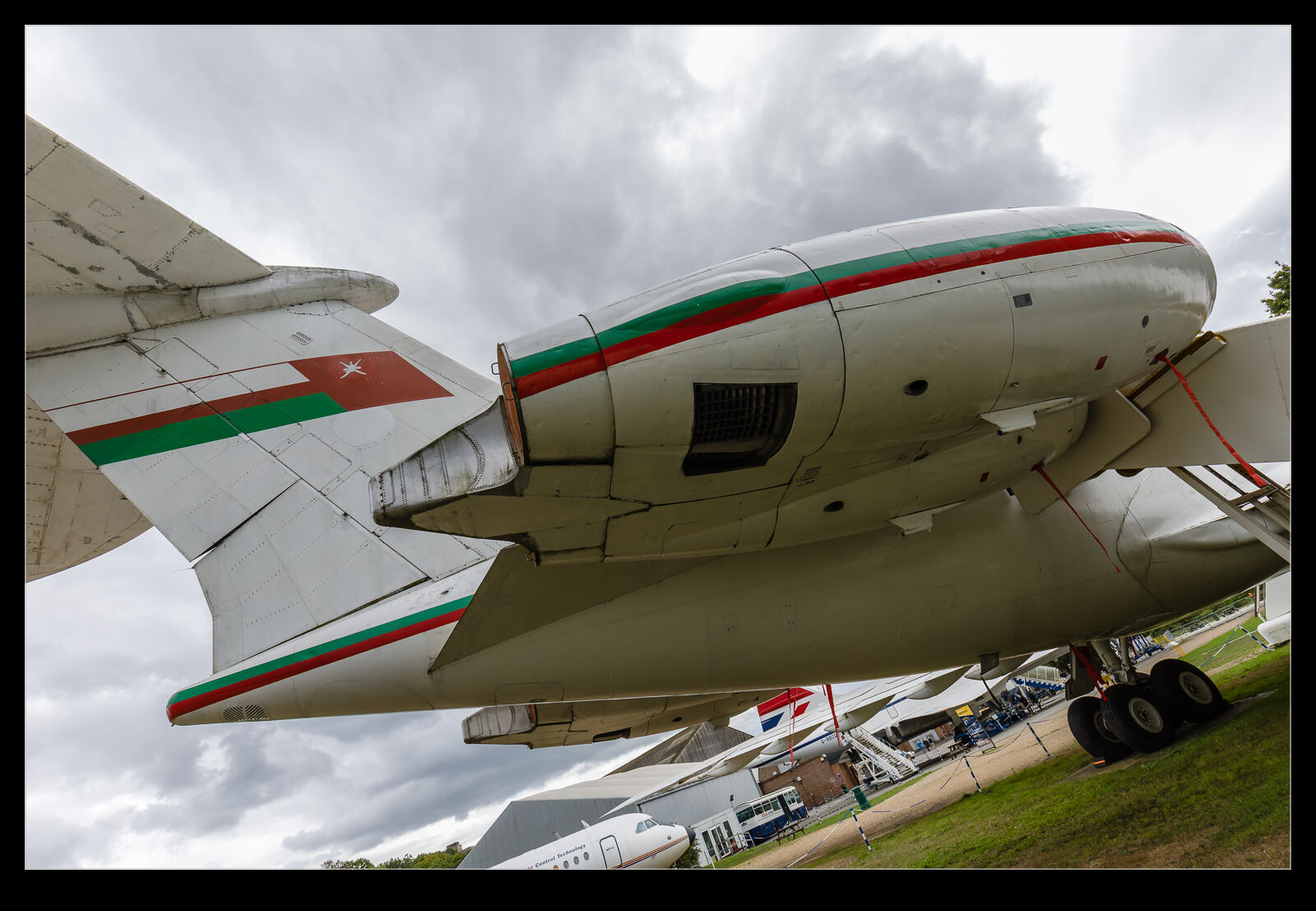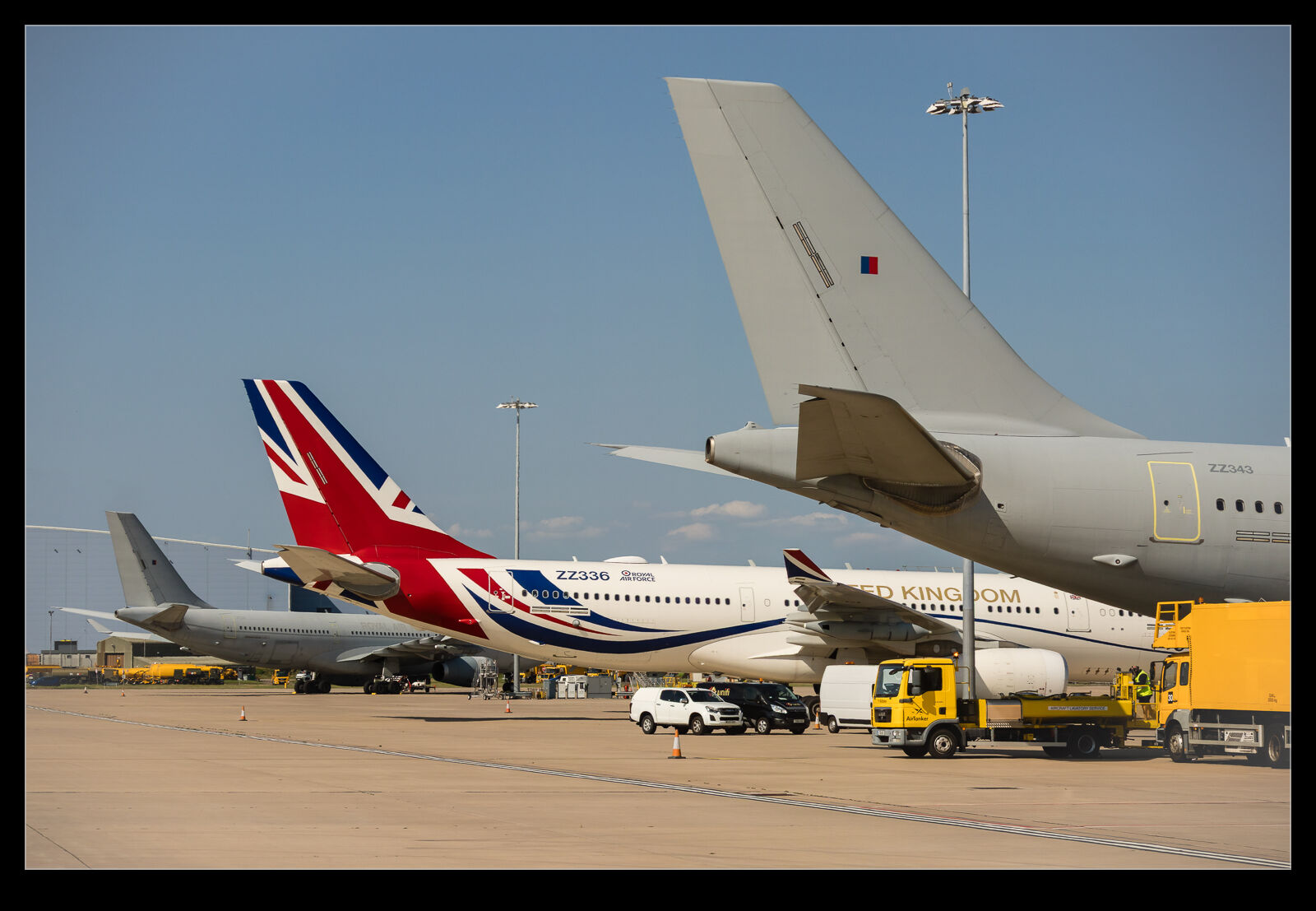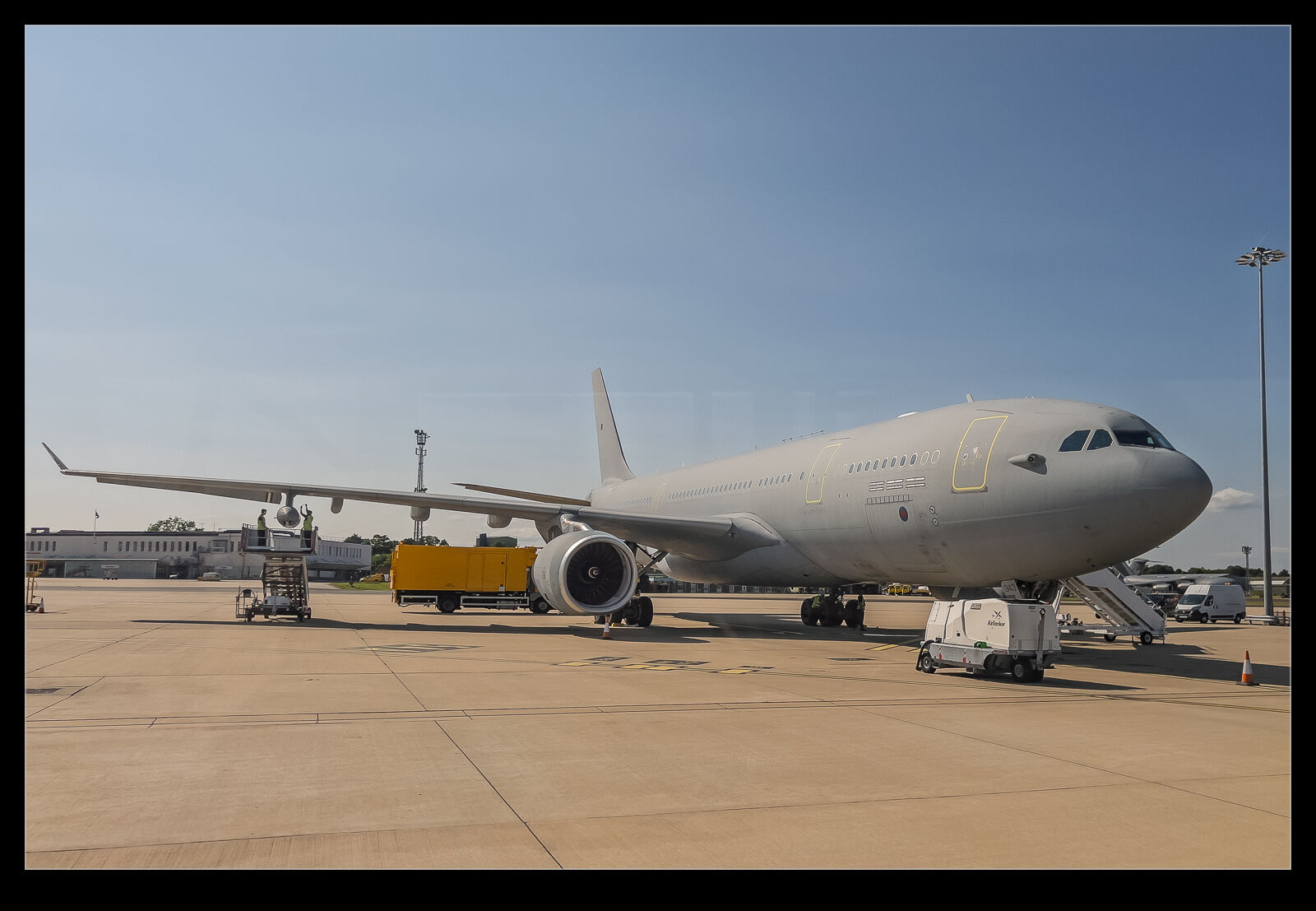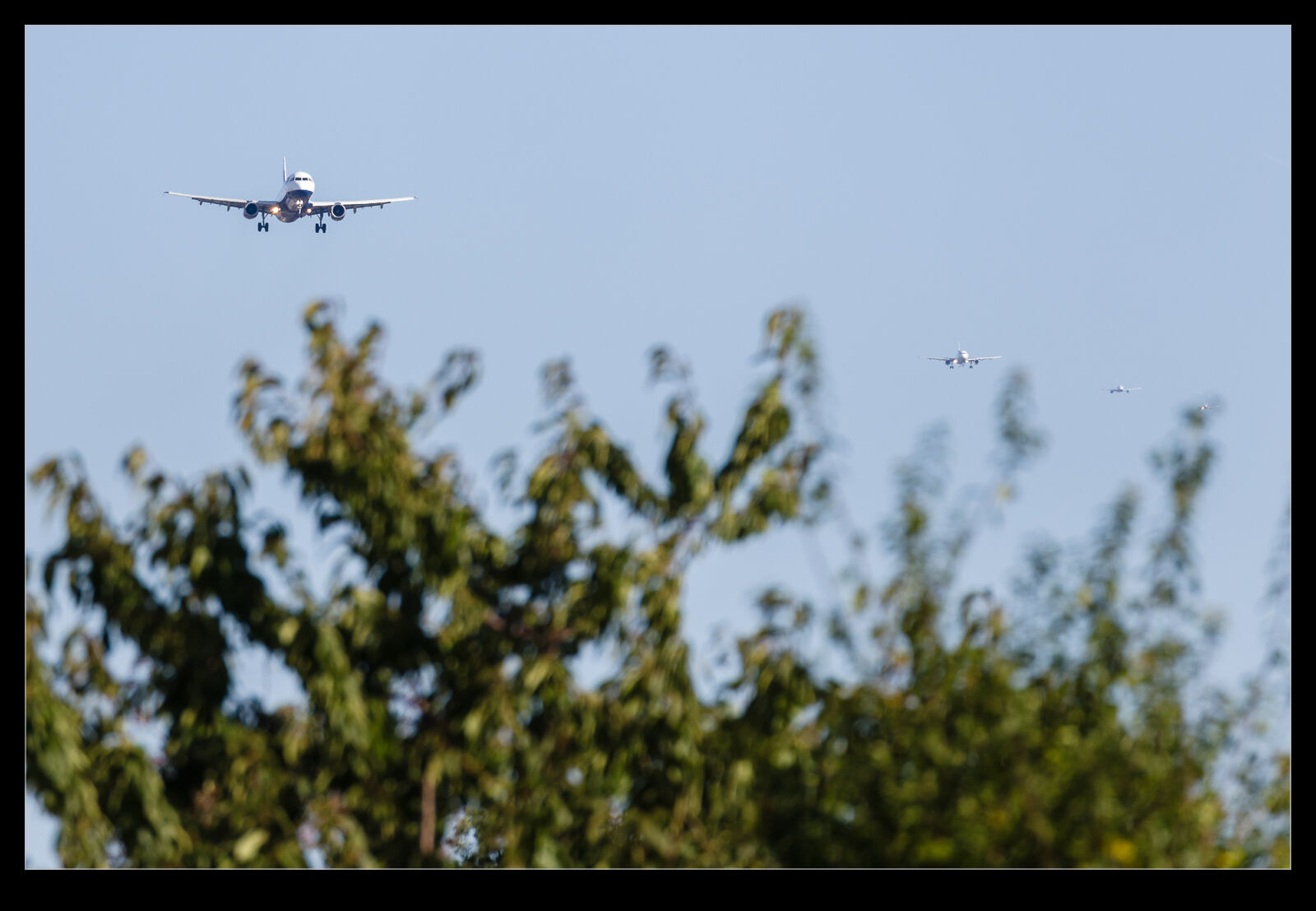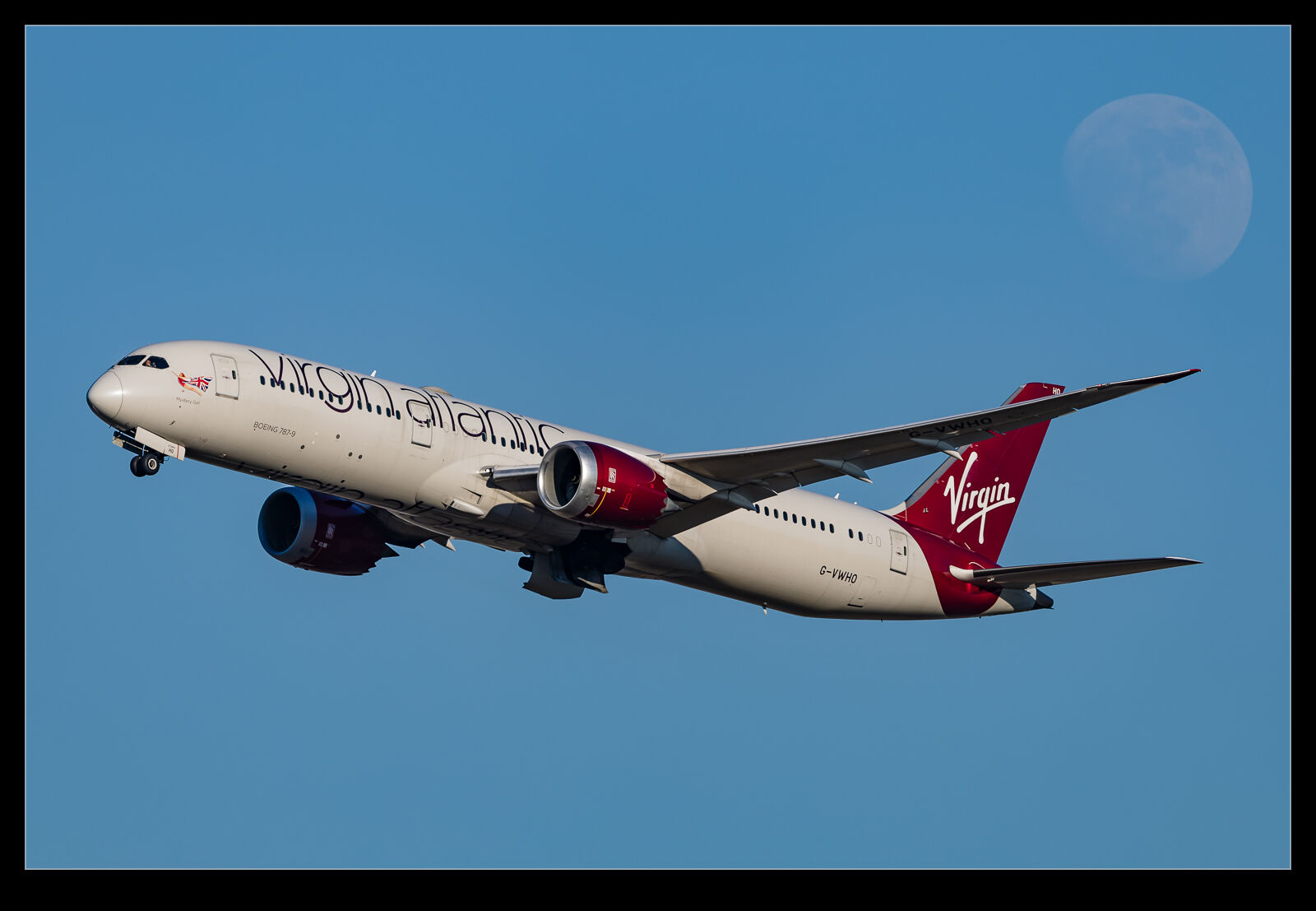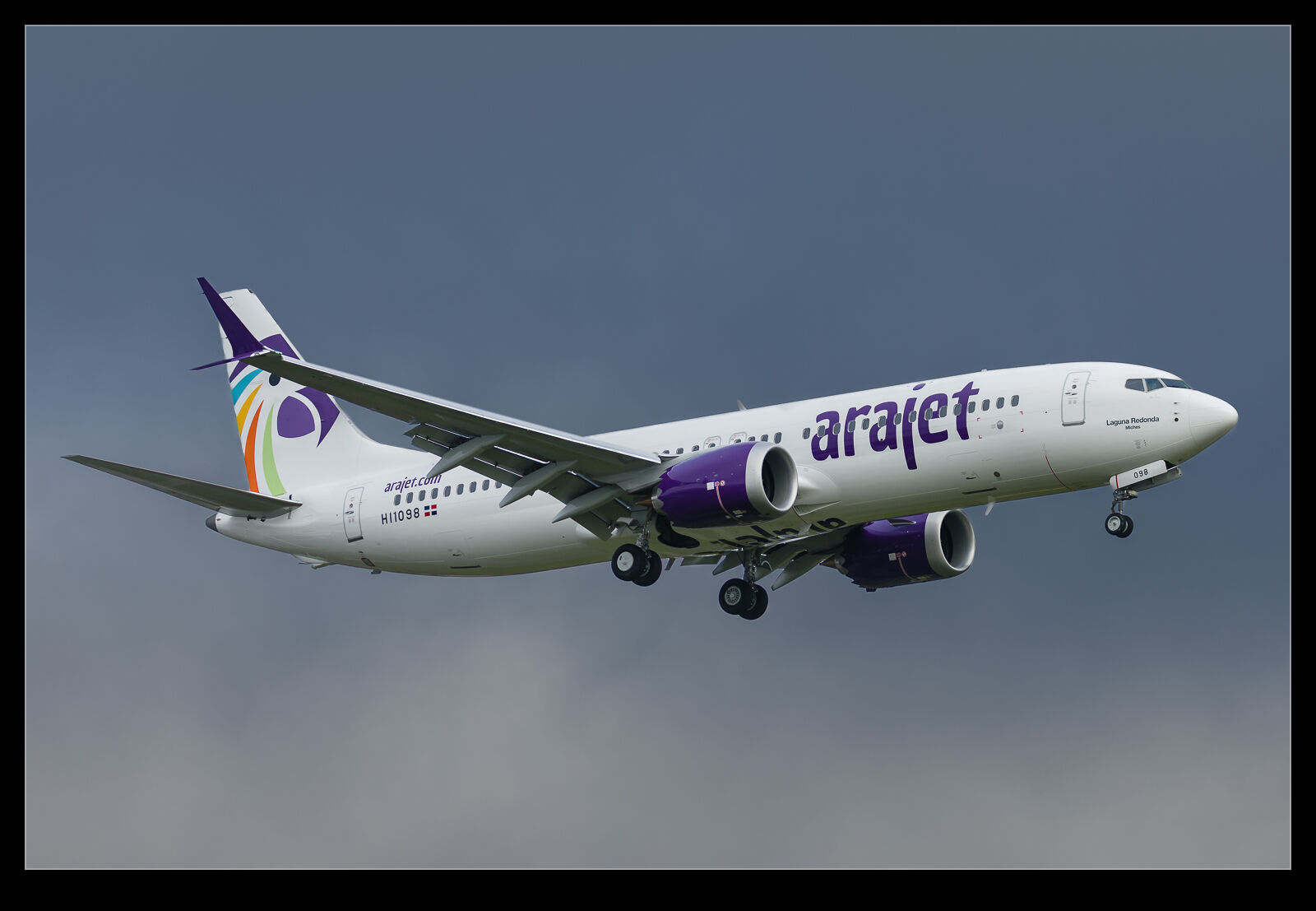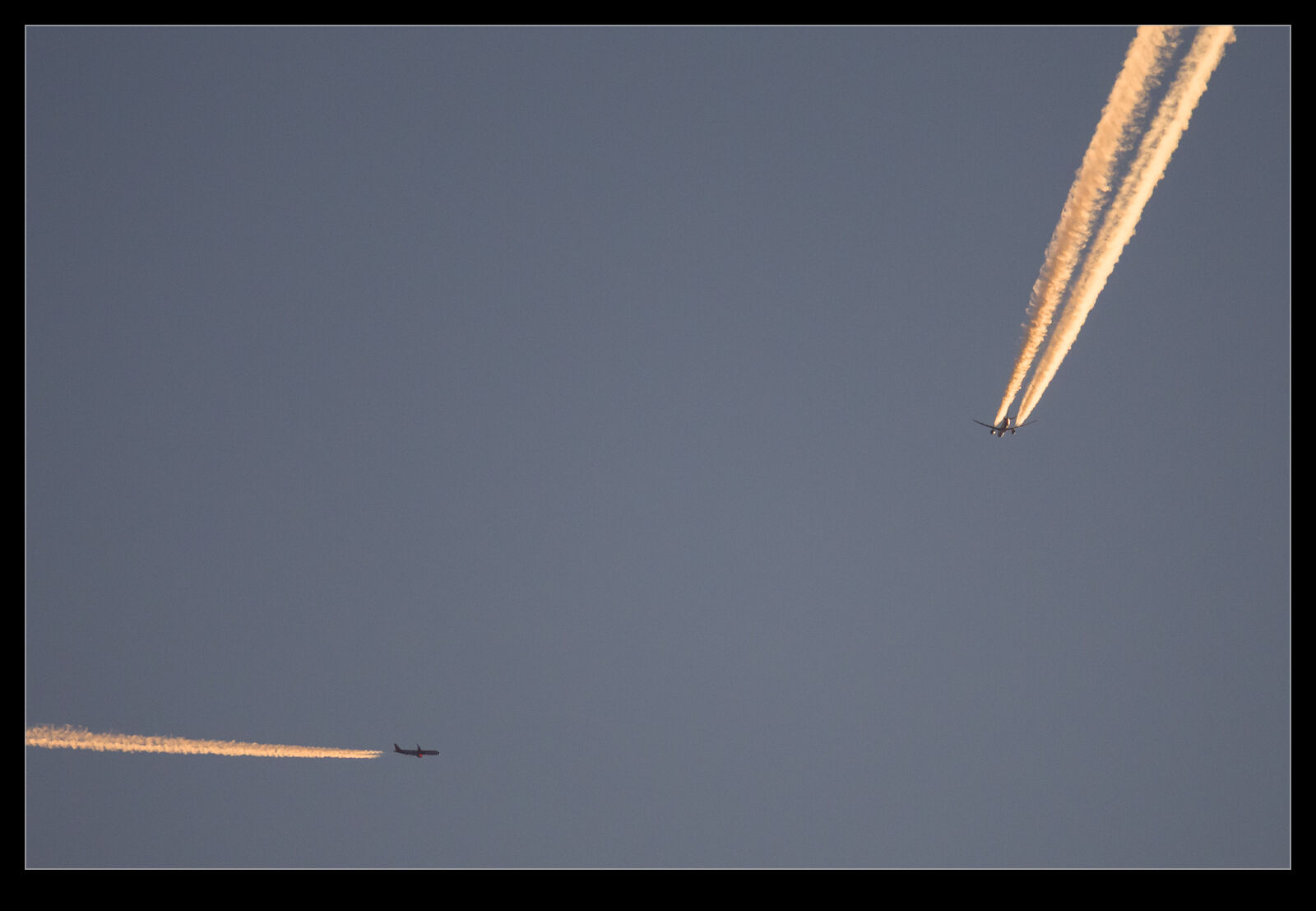 Another of my early morning walks and I looked up at an aircraft contrailing across the sky above me. The low sun angle made the textures of the contrail look good, so I took a few shots. A short while later, I realised that its direction of travel was taking it towards another jet that was crossing its path. I was hoping for the relative positions of the two jets to look like a perfect cross from where I was standing but it wasn’t to be. Even so, they did look like they were crossing quite close.
Another of my early morning walks and I looked up at an aircraft contrailing across the sky above me. The low sun angle made the textures of the contrail look good, so I took a few shots. A short while later, I realised that its direction of travel was taking it towards another jet that was crossing its path. I was hoping for the relative positions of the two jets to look like a perfect cross from where I was standing but it wasn’t to be. Even so, they did look like they were crossing quite close.
Tag Archives: airliner
Wimbledon Special Emirates Climbing Out of Manchester
 We were walking through the grounds of Tatton Park on a recent visit and I was carrying a long lens with me to be ready for the deer that roam the park. However, that was also handy given that the airliners climbing out of Manchester Airport came near us. The conditions were not good for plane photography to be honest. The clouds were often low enough that we never saw the planes but, at one point, I did get a good view of an Emirates A380 climbing overhead and turning in our direction. It had the new Emirates livery combined with special markings for Wimbledon’s tournament earlier this year. A bit of processing was necessary to get it to a reasonable shape.
We were walking through the grounds of Tatton Park on a recent visit and I was carrying a long lens with me to be ready for the deer that roam the park. However, that was also handy given that the airliners climbing out of Manchester Airport came near us. The conditions were not good for plane photography to be honest. The clouds were often low enough that we never saw the planes but, at one point, I did get a good view of an Emirates A380 climbing overhead and turning in our direction. It had the new Emirates livery combined with special markings for Wimbledon’s tournament earlier this year. A bit of processing was necessary to get it to a reasonable shape.
Glasgow Airport Brings Some Variety (At Least for Me)
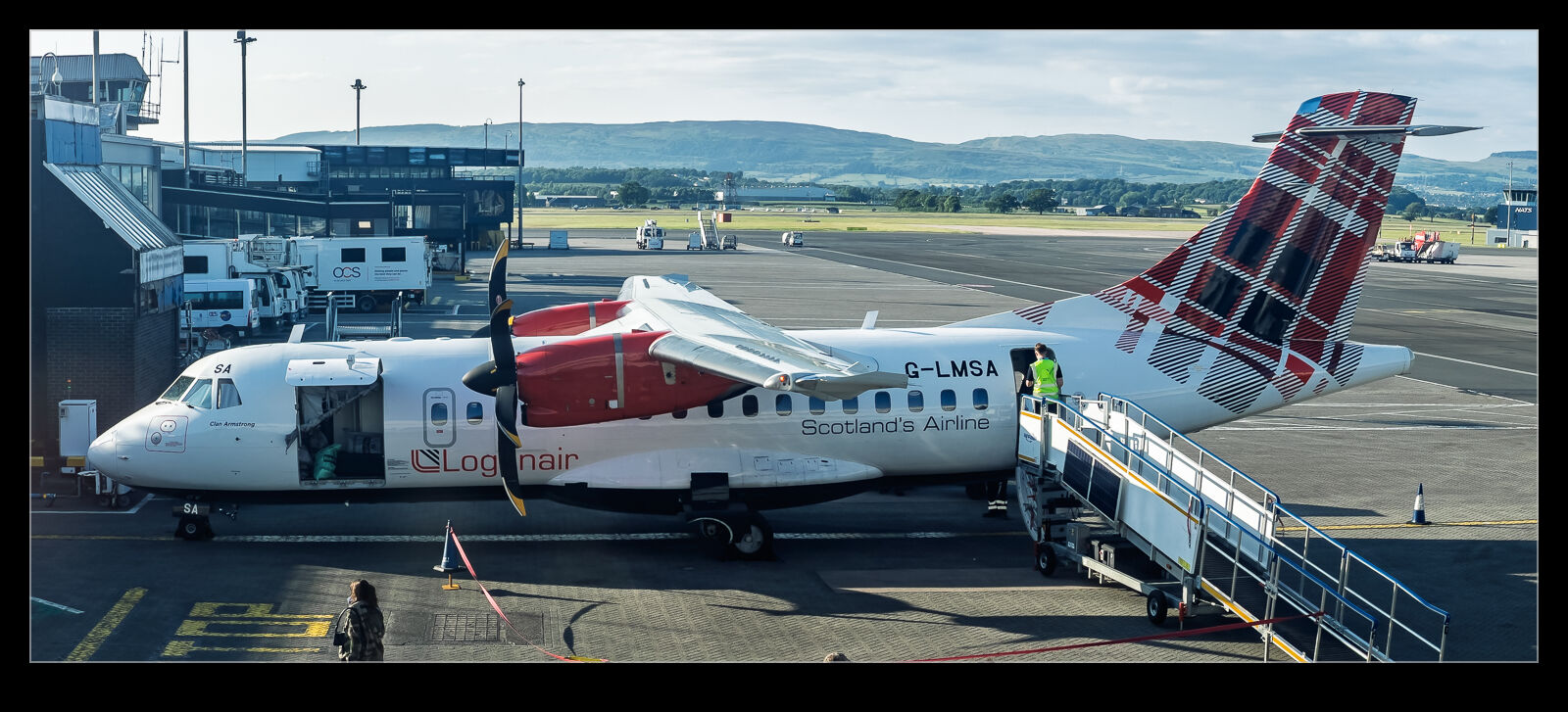 I have had to make a few trips to Glasgow recently and, while some of them involved the train up, I did also fly on occasion. This meant I had some time at Glasgow Airport waiting for my flight home. British Airways and EasyJet are regular features at Glasgow so nothing new about them. However, you get some visitors from Europe and Loganair has a number of turboprops based there so this was a nice chance to see something different to the norm (although I get plenty of ATRs passing the house).
I have had to make a few trips to Glasgow recently and, while some of them involved the train up, I did also fly on occasion. This meant I had some time at Glasgow Airport waiting for my flight home. British Airways and EasyJet are regular features at Glasgow so nothing new about them. However, you get some visitors from Europe and Loganair has a number of turboprops based there so this was a nice chance to see something different to the norm (although I get plenty of ATRs passing the house).
What’s on This Azerbaijan 777’s Fuselage?
 We had an excellent time walking through Windsor Great Park and, while I wasn’t there chasing aircraft, there were a few opportunities to get images of some of the arrivals into Heathrow in the distance. One of these was an Azerbaijan Boeing 777. I grabbed a couple of shots of it as it came over Windsor in the distance and then thought nothing further about it. However, when I started to look through my shots, I noticed some interesting lumps and bumps on the fuselage. My thoughts were immediately that they were some form of defensive countermeasures but if anyone has any other thoughts, I’d be interested to hear them.
We had an excellent time walking through Windsor Great Park and, while I wasn’t there chasing aircraft, there were a few opportunities to get images of some of the arrivals into Heathrow in the distance. One of these was an Azerbaijan Boeing 777. I grabbed a couple of shots of it as it came over Windsor in the distance and then thought nothing further about it. However, when I started to look through my shots, I noticed some interesting lumps and bumps on the fuselage. My thoughts were immediately that they were some form of defensive countermeasures but if anyone has any other thoughts, I’d be interested to hear them.
VC-10 Time
 Our visit to the Brooklands Museum meant were were at the home of the Vickers VC-10. The museum has a complete example along with another fuselage and some test items related to the development of the aircraft that was undertaken here. The complete airframe belonged to the Sultan of Oman and it was flown into Weybridge in the late 80s before the runway was rendered unavailable. It was quite a luxurious configuration in its day but does have a rather basic look compared to what might be available today.
Our visit to the Brooklands Museum meant were were at the home of the Vickers VC-10. The museum has a complete example along with another fuselage and some test items related to the development of the aircraft that was undertaken here. The complete airframe belonged to the Sultan of Oman and it was flown into Weybridge in the late 80s before the runway was rendered unavailable. It was quite a luxurious configuration in its day but does have a rather basic look compared to what might be available today.
On the Voyager Line
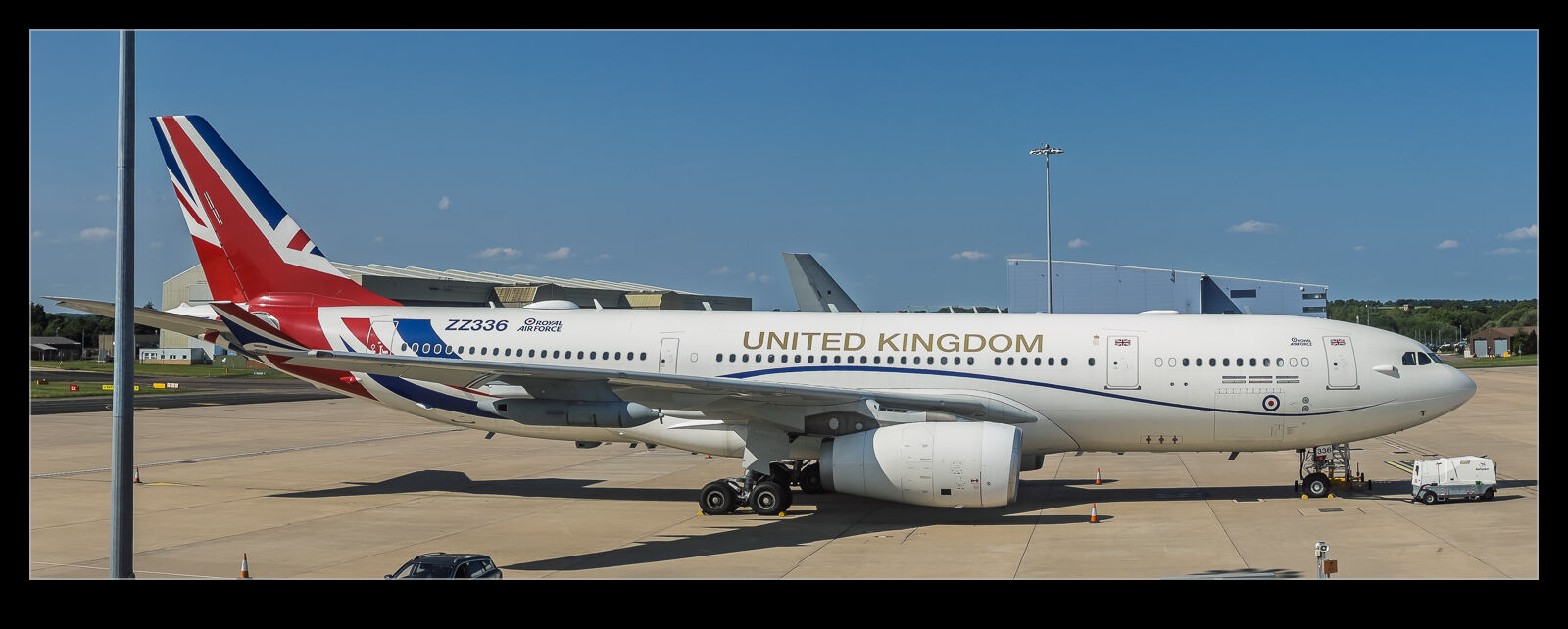 My Voyager ride with 101 Sqn ended back at Brize Norton and we pulled into the line with some other Voyagers. This included Vespina, the jet that is painted in national markings rather than the usual grey. We hung out on the ramp to get a group photo before heading back to the terminal. I got some shots of the Voyagers on the line while I was there (including the jet that we had just been in).
My Voyager ride with 101 Sqn ended back at Brize Norton and we pulled into the line with some other Voyagers. This included Vespina, the jet that is painted in national markings rather than the usual grey. We hung out on the ramp to get a group photo before heading back to the terminal. I got some shots of the Voyagers on the line while I was there (including the jet that we had just been in).
The Approach Is Busy
 Back to a time earlier this year when I made a trip to Heathrow for a brief bit of shooting. Most of the time, I was offset from the approach path to get shots of the jet as they were on short final approach. However, I did walk along to the approach lights to get some head on shots. While there were more about getting a tight angle on the jets and some underside shots, it did also allow me to look back up the approach and see a number of jets on the glideslope or turning to line up. Heathrow is a busy place so there always seem to be jets on approach.
Back to a time earlier this year when I made a trip to Heathrow for a brief bit of shooting. Most of the time, I was offset from the approach path to get shots of the jet as they were on short final approach. However, I did walk along to the approach lights to get some head on shots. While there were more about getting a tight angle on the jets and some underside shots, it did also allow me to look back up the approach and see a number of jets on the glideslope or turning to line up. Heathrow is a busy place so there always seem to be jets on approach.
Stormy Sunday Atlas 777F
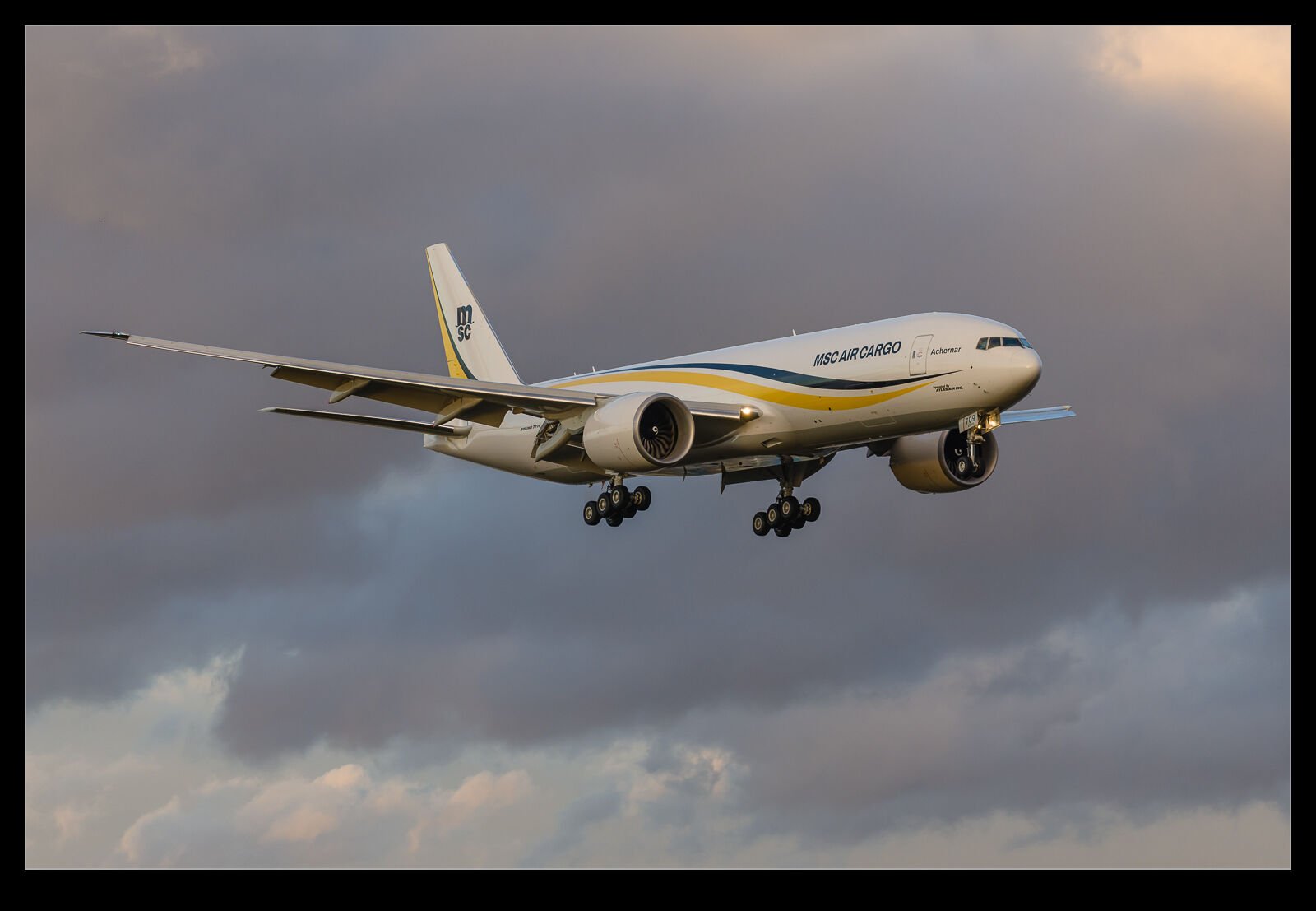 A stormy sky doesn’t immediately inspire you when going for some aircraft photography but, if the light on the subject can end up being okay, a dark background can suddenly seem like a great option. One Sunday an Atlas 777F was up on test at Paine Field. The sky was dark and gloomy but not a solid cloud background. Instead, the clouds were stratified so there was more detail and texture to see.
A stormy sky doesn’t immediately inspire you when going for some aircraft photography but, if the light on the subject can end up being okay, a dark background can suddenly seem like a great option. One Sunday an Atlas 777F was up on test at Paine Field. The sky was dark and gloomy but not a solid cloud background. Instead, the clouds were stratified so there was more detail and texture to see.
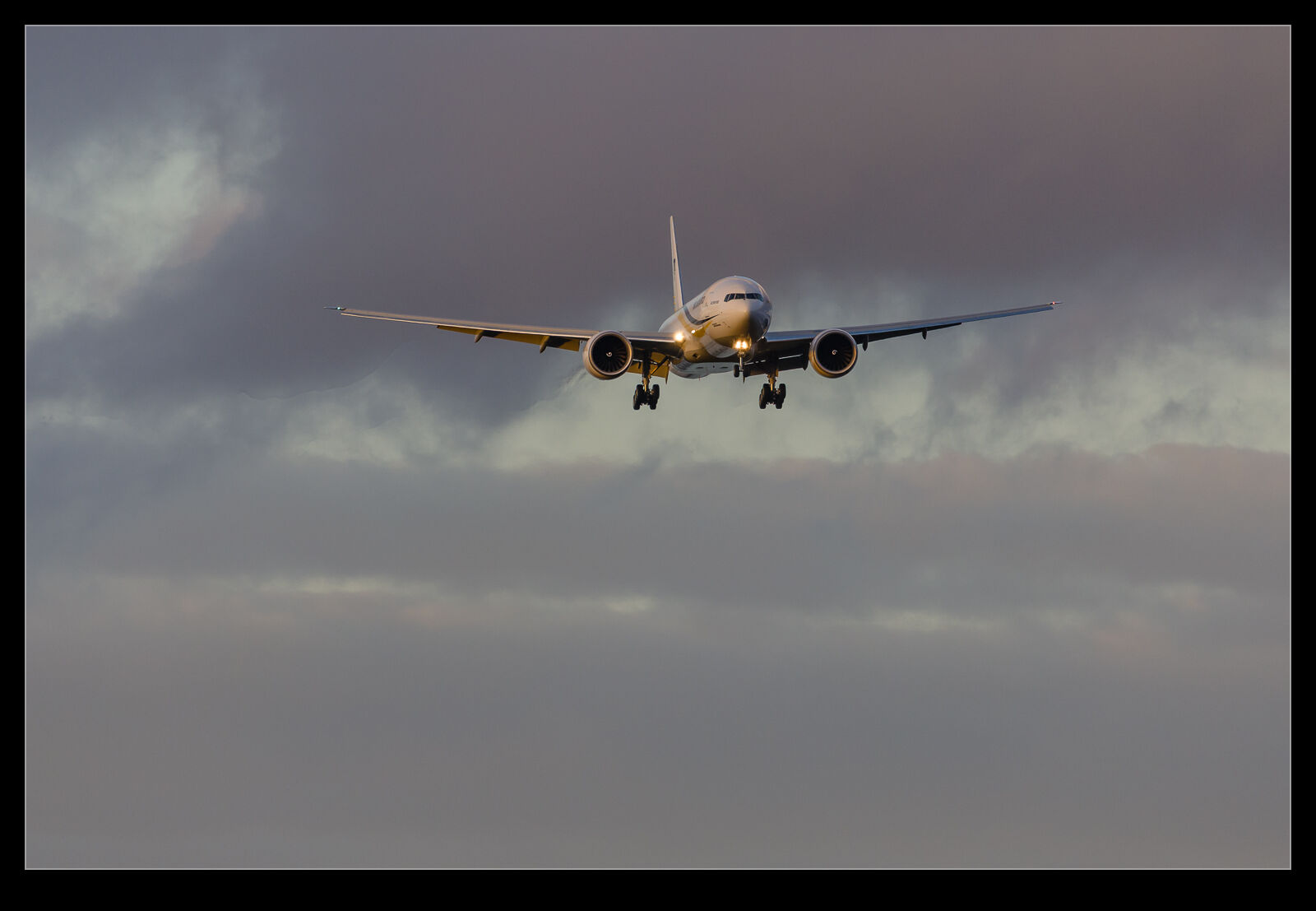 As the 777 came down the approach, it was not brightly illuminated but it was picking up a good amount of light compared to what I had expected to be the case. This did require some thought about the camera settings. When the sky is dark, I often significantly over-expose. This is because the clouds will dominate the metering response and the subject – which is usually quite dark – really disappears. In post processing I can then bring the exposure back down but there is sufficient light on the subject to get a good image of it against the sky.
As the 777 came down the approach, it was not brightly illuminated but it was picking up a good amount of light compared to what I had expected to be the case. This did require some thought about the camera settings. When the sky is dark, I often significantly over-expose. This is because the clouds will dominate the metering response and the subject – which is usually quite dark – really disappears. In post processing I can then bring the exposure back down but there is sufficient light on the subject to get a good image of it against the sky.
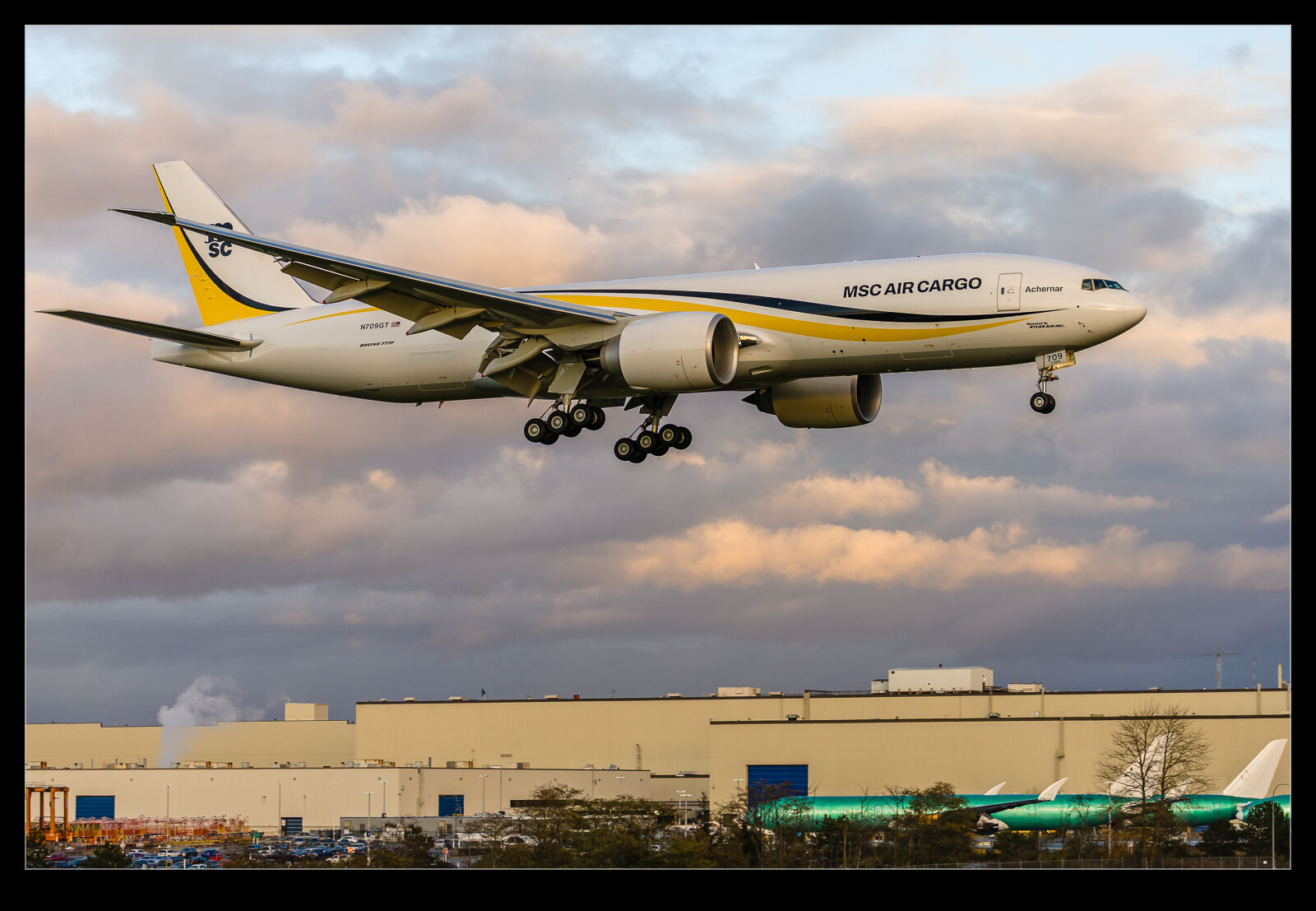 In this case, I had to be more careful. With good light on the subject, the dark sky would result in blowing out the plane. Therefore, I had to keep the exposure compensation off to allow the subject to not get too overexposed and not leave enough latitude for processing it to where I wanted it to be. The results came out okay. This was more important for the longer shots. Once the plane was close in, it started to dominate the metering response and, once on the ground, the illumination was more balanced.
In this case, I had to be more careful. With good light on the subject, the dark sky would result in blowing out the plane. Therefore, I had to keep the exposure compensation off to allow the subject to not get too overexposed and not leave enough latitude for processing it to where I wanted it to be. The results came out okay. This was more important for the longer shots. Once the plane was close in, it started to dominate the metering response and, once on the ground, the illumination was more balanced.
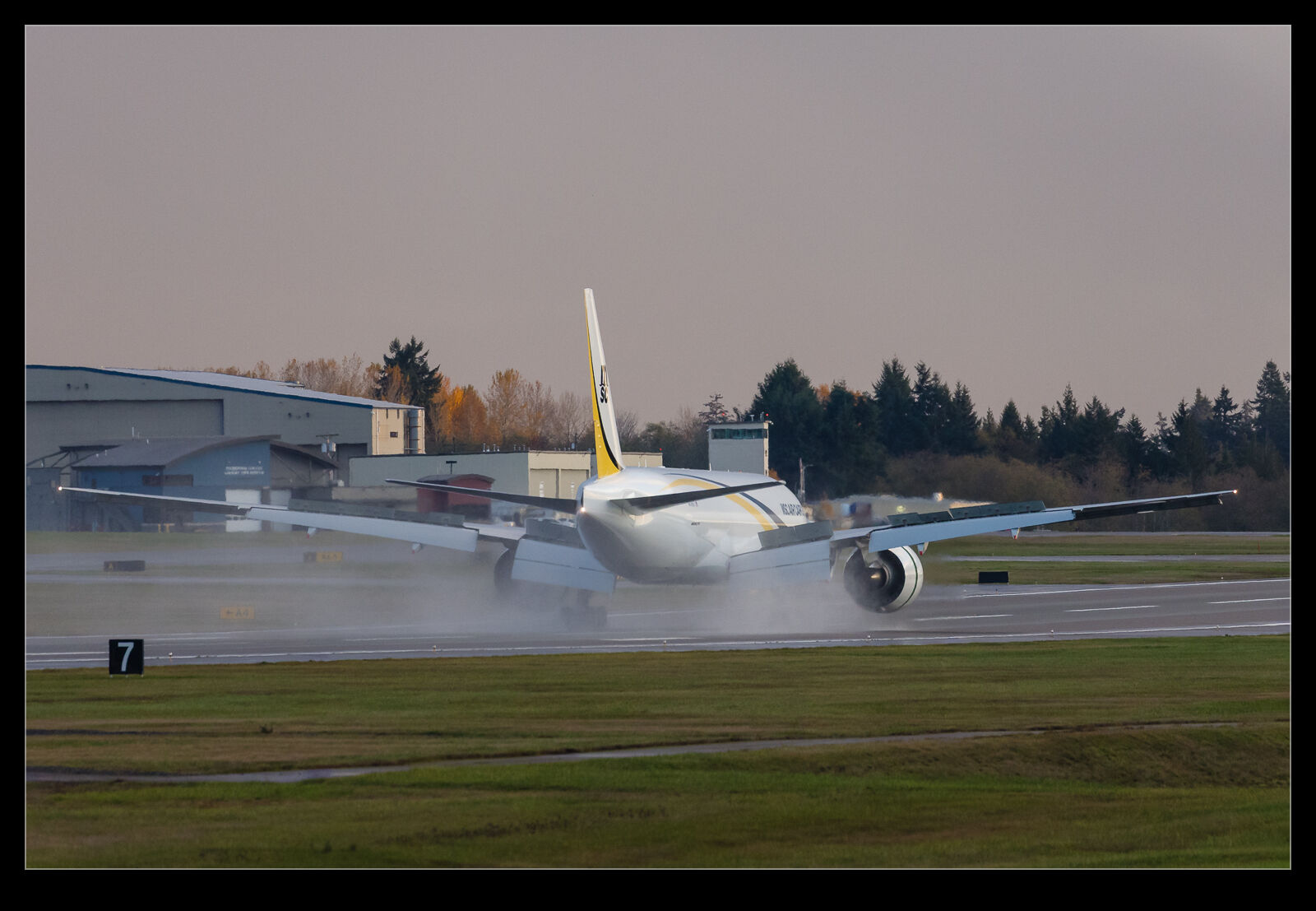 Once they touched down and brought in the reversers, you could see that the conditions had not long ago been wet as the runway still had plenty of water on the surface and the reversers kicked it up in the air.
Once they touched down and brought in the reversers, you could see that the conditions had not long ago been wet as the runway still had plenty of water on the surface and the reversers kicked it up in the air.
Getting the Moon in Some Shots
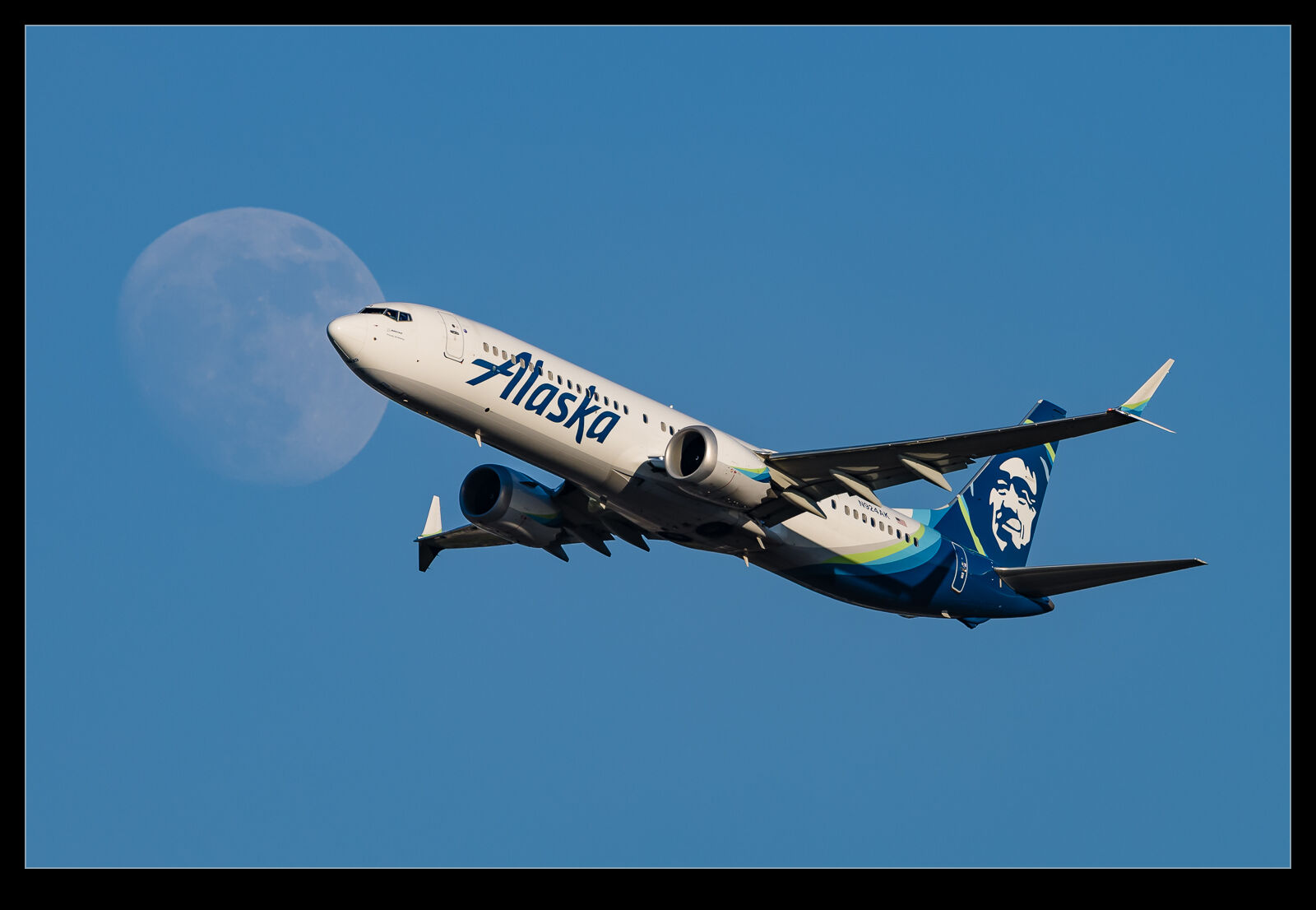 If you are shooting at the time of the month when the moon is close to full, it should mean it will show up in the background at some point when you have afternoon/evening light behind you. Will it make it into your shot? Probably not. The angles the planes take vary and the moon is constantly moving in the background so, while you can anticipate it might work out at some point and hope accordingly, that doesn’t mean it will work. Of course, you can also forget about it for a while and miss a perfectly good moon shot too – who would do that though?
If you are shooting at the time of the month when the moon is close to full, it should mean it will show up in the background at some point when you have afternoon/evening light behind you. Will it make it into your shot? Probably not. The angles the planes take vary and the moon is constantly moving in the background so, while you can anticipate it might work out at some point and hope accordingly, that doesn’t mean it will work. Of course, you can also forget about it for a while and miss a perfectly good moon shot too – who would do that though?
 At various times when shooting departures are Seattle Tacoma International Airport, I did get the moon to show up in the shots. Would it be with the most interesting aircraft in the foreground? Probably not. More likely to be an Alaska Airlines jet since they are the most common departure (and also the one more likely to have made me not be getting a shot) but that is still fine. Here are some results from across various shoots.
At various times when shooting departures are Seattle Tacoma International Airport, I did get the moon to show up in the shots. Would it be with the most interesting aircraft in the foreground? Probably not. More likely to be an Alaska Airlines jet since they are the most common departure (and also the one more likely to have made me not be getting a shot) but that is still fine. Here are some results from across various shoots.
Arajet But Without the Paint
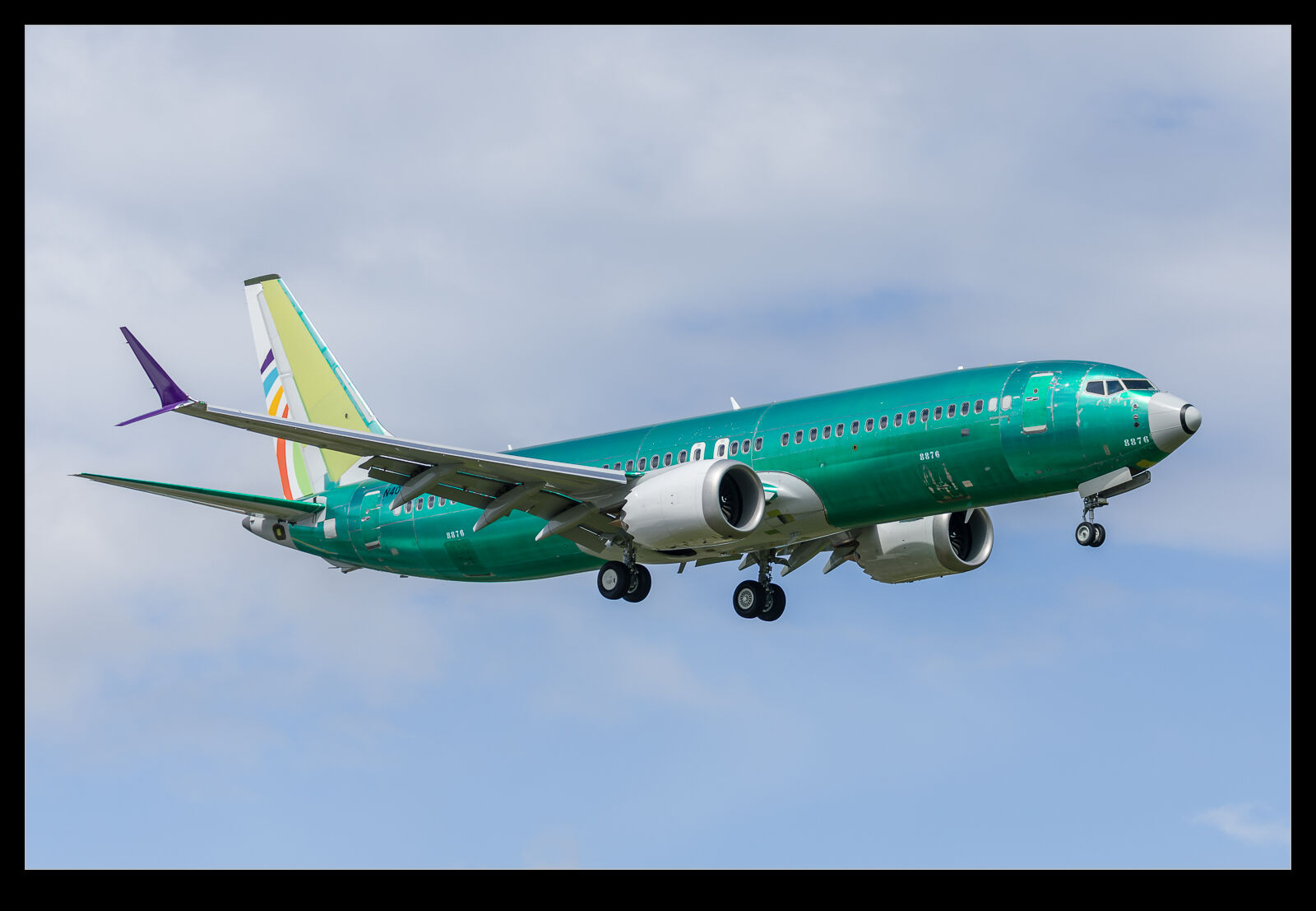 Having Boeing on your doorstep means the chance to photograph airlines that you have a good chance of never seeing in their normal operations. Arajet, of the Dominican Republic, is one such airline. As they were taking delivery of some 737 Max jets, I was able to photograph them. On one occasion, I was out at Boeing Field when one of their jets was on test and I was looking forward to getting a shot. Unfortunately, I didn’t know it hadn’t yet been painted. Instead, I got a green plane with only the rudder and winglets giving away who the ultimate operator would be
Having Boeing on your doorstep means the chance to photograph airlines that you have a good chance of never seeing in their normal operations. Arajet, of the Dominican Republic, is one such airline. As they were taking delivery of some 737 Max jets, I was able to photograph them. On one occasion, I was out at Boeing Field when one of their jets was on test and I was looking forward to getting a shot. Unfortunately, I didn’t know it hadn’t yet been painted. Instead, I got a green plane with only the rudder and winglets giving away who the ultimate operator would be
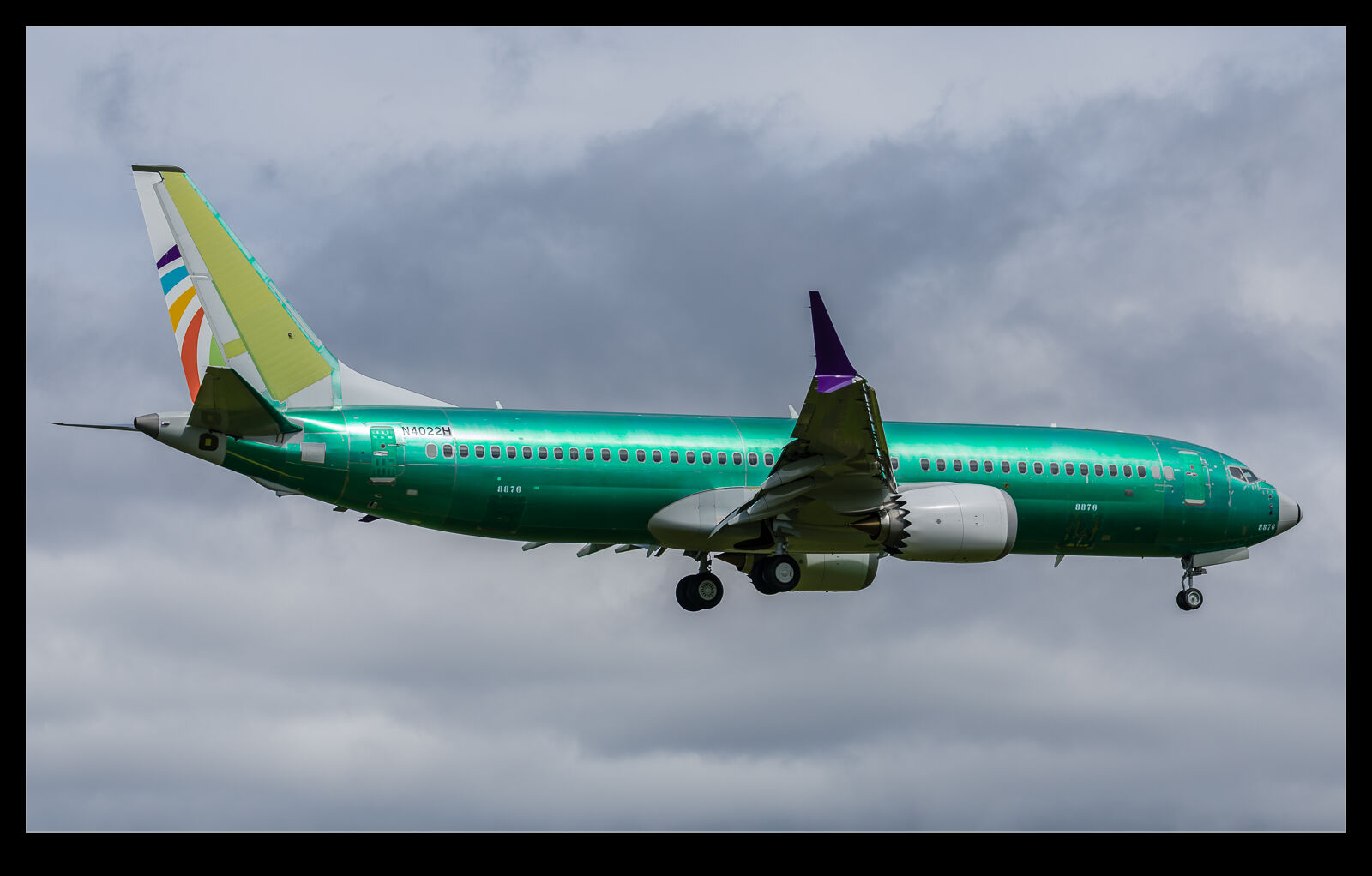 I like the green of the unpainted jets and primer finishes on other planes also look good to me. I wasn’t so upset as a result, but it wasn’t exactly what I was hoping for. Still, it looked pretty good on approach. I did get another airframe in the finished livery so I will stick that at the bottom to show what this one would ultimately look like. Not a dramatic livery but something different.
I like the green of the unpainted jets and primer finishes on other planes also look good to me. I wasn’t so upset as a result, but it wasn’t exactly what I was hoping for. Still, it looked pretty good on approach. I did get another airframe in the finished livery so I will stick that at the bottom to show what this one would ultimately look like. Not a dramatic livery but something different.

